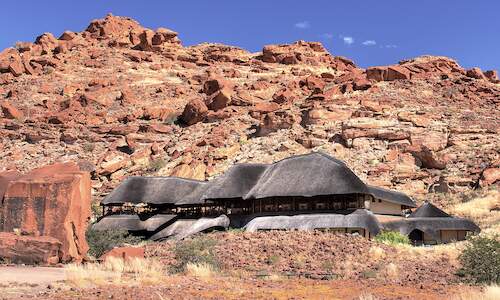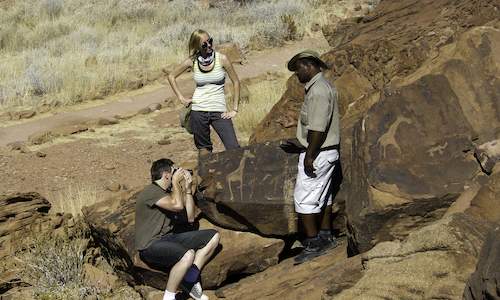
The story of the region is centred around David Levin, the topographer. He rediscovered a spring that ran through the area but was unable to get enough water from it to sustain his family and herds of animals. David soon began to have doubts about the capacity of the spring, and this led a local farmer nicknaming him David Twyfelfontein.'Twyfel' means 'questionable' or 'uncertain' and thus his nickname meant David 'Doubts-the-Spring'. David Levin later purchased the land in 1948 and gave it the name Twyfelfontein.
Situated 100 kilometres (62 miles) from the sea, in an area where the Namib Desert becomes Damaraland and the scenery changes from dry red sands to lush waving grassland, one will find a broad valley that stretches out across the sandstone plateau. It is here that Twyfelfontein and the incredible rock engravings are found.While rock engravings are found all over the world, although mostly in Africa; the rock art engravings at Twyfelfontein are the largest and are considered the most important concentration of rock art in Africa, with over 2 500 petroglyphs in a variety of different styles, being found here.
The engravings were first discovered before 1914 by Reinhardt Maack who later published a report in 1921 which brought a lot of attention to the site, and many visitors. The difference between these engravings and the rock paintings one often sees, is that rock paintings are usually found in rock shelters or in caves while these engravings are found in the open air.

By working away at the rock the San people were able to cut through and remove the outer layer and reach the yellower shaded rock below. Over the years the engravings have been oxidised which has helped to seal and preserve the engravings.
The engravings show depictions of both human and animal tracks as well as a variety of animals that must have been found in the area or seen by the San people during that period. These animal depictions include Ostrich, Lion, Zebra, Kudu and even Penguins and Seals which is a strong indication that these people were travelling to and from the sea as well as roaming inland.Scientists believe that the site was inhabited, first by hunter-gatherers and then by Khoikhoi herders and was used as a place of worship where they could conduct rituals. It was during these rituals that most of these engravings would have been made.
Today visitors can reach the historical site by travelling along the B1 road and then turning off onto the C39 then taking the D2612, D3254 and finally the D3214 roads until they reach the visitors centre. The visitors centre is an interesting building as was built using no cement, only recycled materials and can be easily dismantled, leaving no impression on the landscape.
Visitors can take a guided tour where an enthusiastic local guide will take you along the stone pathway and across the viewing platforms to view some of the engravings and teach you about the history of the area and some of the San people's customs and beliefs.The walk is highly enjoyable and the tour is definitely recommended. The excursion also provides an excellent opportunity to leave your vehicle for a while and take in the sights and sounds of your natural surroundings.

 This Damaraland lodge in Namibia offers great examples of Bushman paintings and San rock art. Guests at Twyfelfontein Country Lodge...
This Damaraland lodge in Namibia offers great examples of Bushman paintings and San rock art. Guests at Twyfelfontein Country Lodge... Things to do in Damaraland - A guide to visiting the ancient Bushmen rock art displays at Twyfelfontein and tracking the desert-adapted wild...
Things to do in Damaraland - A guide to visiting the ancient Bushmen rock art displays at Twyfelfontein and tracking the desert-adapted wild...